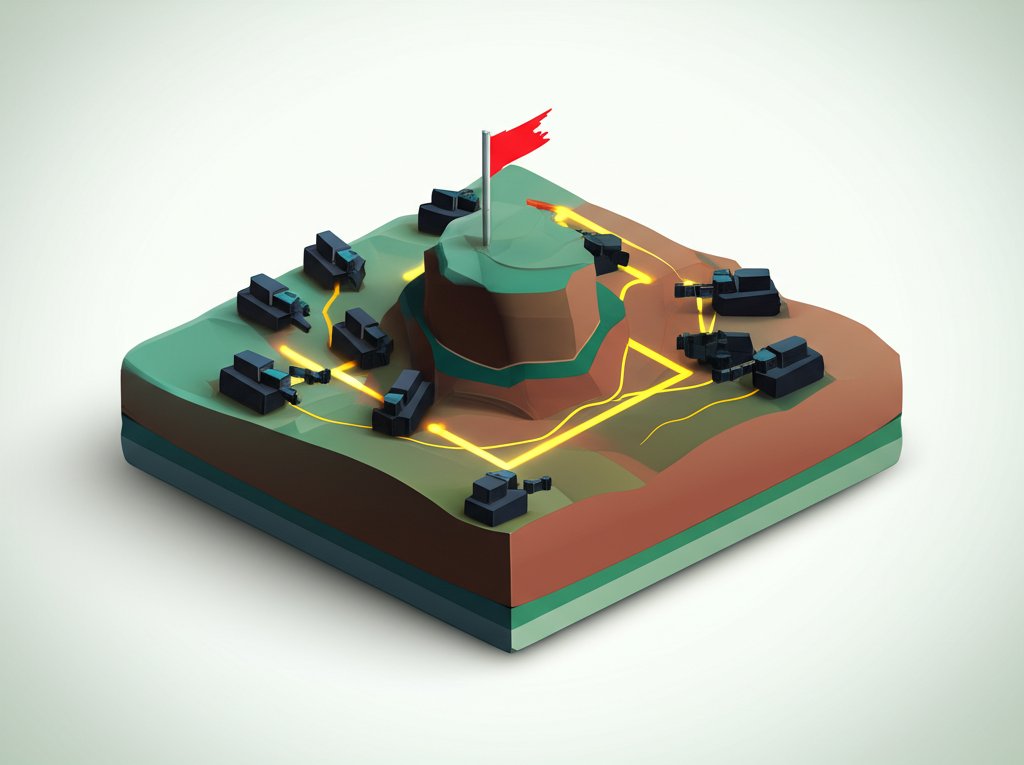Throughout history, the narrative of warfare often celebrates the might of empires and the overwhelming power of vast armies. Yet, woven into the fabric of military annals are extraordinary stories of underdog military victors – forces that, against all logical predictions, defied numerical, technological, or logistical superiority to achieve glorious triumph against the odds. These incredible underdog military victories are not random occurrences; they are the profound result of brilliant military strategy, unwavering resolve, and a deep understanding of the battlefield.
This article delves into the captivating world of these improbable triumphs. We will unearth the core principles of military strategy that allowed smaller, less-equipped forces to outmaneuver and defeat their formidable adversaries. By examining pivotal historical battles, we aim to understand the tactical genius, psychological fortitude, and innovative approaches that transformed certain defeat into resounding success, proving that true power on the battlefield isn’t always measured in numbers, but in cunning and spirit. Prepare to discover how these relentless military victors rewrote the rules of war.
The Enduring Power of the Underdog: Defining Underdog Military Victories
Achieving such astounding underdog military victories often hinges on the leadership qualities exemplified by figures discussed in our exploration of iconic military leaders, individuals who turned disadvantages into strategic advantages.
The concept of the “underdog” captivates us because it speaks to a fundamental human desire for justice and the belief that anything is possible. In military contexts, an underdog is typically a force facing quantifiable disadvantages: fewer soldiers, weaker weaponry, less training, inferior supplies, or a less advantageous position. Yet, time and again, these forces rise to become underdog military victors, leaving an indelible mark on history.
What Constitutes an Underdog in Military History?
An underdog is not simply a smaller force; it’s a force facing a disproportionate challenge. This could manifest in several ways:
- Numerical Disparity: The most common form, where one side is drastically outnumbered.
- Technological Gap: Relying on older or less advanced equipment against a state-of-the-art adversary.
- Logistical Weakness: Struggling with supply lines, food, or ammunition while the enemy is well-provisioned.
- Geopolitical Isolation: Lacking powerful allies or external support.
- Morale and Training: Sometimes, the underdog might even face internal divisions or a perceived inferiority in training, which they must overcome.
The essence of the underdog is the expectation of failure. When this expectation is shattered, it validates the power of ingenuity, leadership, and determination over sheer might.
Why Do These Triumphs Against the Odds Resonate?
Stories of triumph against the odds are more than just historical footnotes; they are sources of profound inspiration. They showcase humanity’s capacity for resilience, innovation, and courage when pushed to the brink. These narratives underscore the idea that with the right military strategy and spirit, even the impossible can be achieved. They teach us that:
- Resourcefulness is Key: Limitations often breed creativity, forcing commanders to think outside the box.
- Motivation Matters: A highly motivated force fighting for survival, freedom, or a deeply held belief can overcome significant material deficits.
- Leadership is Paramount: Visionary generals can inspire loyalty, devise brilliant plans, and make critical decisions under immense pressure.
These victories serve as powerful reminders that the human element, often overlooked in the calculus of war, can be the most decisive factor.
Mastering the Battlefield: Core Military Strategy for Overcoming Odds
The transformation from underdog to military victors is rarely accidental. It is almost always a testament to superior military strategy – a grand design that leverages every available asset and exploits every enemy weakness. Underdogs, by necessity, cannot afford direct attrition warfare. Their strategies must be asymmetric, unconventional, and perfectly executed.
Innovation and Asymmetric Warfare
When conventional strength is lacking, unconventional approaches become essential. Asymmetric warfare involves exploiting differences between opponents to create advantages. This might mean:
- Guerrilla Tactics: Small, highly mobile units conducting raids, ambushes, and sabotage, avoiding direct confrontation with superior forces. This strategy wears down the enemy, disrupts their logistics, and erodes their morale.
- Technological Ingenuity: While often outmatched, underdogs can sometimes innovate or adapt existing technologies in novel ways. Examples include the effective use of fortifications, traps, or even the psychological impact of new weapons.
- Strategic Deception: Employing feints, false intelligence, and misleading maneuvers to confuse the enemy, divide their forces, or lure them into traps.
Exploiting Terrain and Environment
The battlefield itself can become the underdog’s most potent ally. A deep understanding and masterful use of terrain can negate enemy advantages and amplify one’s own.
- Chokepoints and Defiles: Utilizing narrow passes, mountain ranges, or dense forests to funnel larger enemy forces, reducing their numerical superiority and making them vulnerable to concentrated attack.
- Weather Conditions: Leveraging extreme heat, cold, fog, or storms to disrupt enemy operations, especially if the underdog is acclimatized or better equipped for such conditions.
- Familiarity: Forces fighting on their home ground possess intimate knowledge of paths, hidden routes, and defensive positions, allowing for effective ambushes and evasive maneuvers.
Superior Leadership and Morale
Even the most brilliant military strategy requires execution, and that relies heavily on leadership and the fighting spirit of the troops.
- Visionary Leadership: Commanders who can inspire confidence, articulate a clear vision, and make audacious decisions. They understand their troops’ capabilities and motivate them to exceed expectations.
- High Morale and Motivation: Soldiers fighting for a cause they deeply believe in – be it freedom, homeland, or ideology – will often endure greater hardships and display greater tenacity. This psychological edge can turn the tide in critical moments.
- Discipline and Training: Despite perceived disadvantages, underdogs often possess highly disciplined and well-trained units, honed through necessity and a commitment to survival.
The Element of Surprise
Surprise is a force multiplier, especially for an underdog. Catching a stronger enemy off guard can disrupt their plans, sow confusion, and prevent them from bringing their full strength to bear.
- Unexpected Attack: Launching an assault at an improbable time or from an unforeseen direction.
- Rapid Maneuver: Swiftly moving forces to achieve local superiority at a critical point before the enemy can react.
- Concealment and Stealth: Hiding intentions and movements until the decisive moment.
Case Studies in Triumph: Historical Battles That Redefined Expectations
The annals of history are replete with historical battles where incredible underdog military victories occurred. These examples serve as powerful illustrations of how master military strategy can overcome overwhelming odds.
The Battle of Marathon: Athenian Ingenuity vs. Persian Might (490 BC)
One of the most iconic underdog military victories, the Battle of Marathon saw a numerically inferior Athenian-Plataean force confront the vast Persian Empire, then the greatest military power in the world. The Persians, with an army estimated to be several times larger, landed at Marathon, intending to conquer Athens.
The Athenian general Miltiades understood that a direct confrontation would be suicidal. His military strategy hinged on leveraging the terrain and the unique strengths of his hoplite infantry. He deployed his forces with a deliberately weak center and strong flanks, a counter-intuitive formation. When the Persian lines advanced, the Athenian center gave ground, drawing the Persians deeper into the trap. The heavily armored Athenian flanks then enveloped the Persian forces, crushing them in a double envelopment. The Persians, unaccustomed to such fierce resistance and fighting in close quarters, panicked and were routed.
- Key Strategies: Strategic deployment, utilization of terrain to negate Persian cavalry advantage, disciplined hoplite formation, decisive flanking maneuver.
- Outcome: A stunning Athenian victory, repelling the Persian invasion and boosting Greek morale for future conflicts. This was a true triumph against the odds.
The Battle of Agincourt: English Archery’s Decisive Edge (1415)
The Battle of Agincourt is a classic example of a determined English force achieving triumph against the odds against a much larger and better-equipped French army during the Hundred Years’ War. King Henry V of England, with an exhausted and disease-ridden army, found himself blocked by a massive French host.
Henry V’s military strategy capitalized on two key factors: the devastating power of the English longbow and the boggy, muddy terrain. He deployed his archers on the flanks of his small dismounted knight and man-at-arms formation, driving stakes into the ground to defend against cavalry charges. The French, overconfident and eager for glory, launched wave after wave of heavily armored knights and men-at-arms across the narrow, muddy field. Many were bogged down, becoming easy targets for thousands of longbow arrows. The sheer volume of arrows, coupled with the dense, immobile French ranks, led to catastrophic casualties. The French cavalry charges were broken, allowing the English men-at-arms to engage and further decimate the disorganized French forces.
- Key Strategies: Exploiting terrain (mud), innovative use of defensive structures (stakes), technological superiority (longbow, though not strictly an underdog tech, its deployment was strategic), disciplined defense.
- Outcome: A decisive English victory, crushing French chivalry and significantly impacting the course of the Hundred Years’ War. A clear example of how
military victorscan emerge from tactical brilliance.
The Winter War: Finnish Sisu Against the Soviet Behemoth (1939-1940)
The Winter War saw tiny Finland, a nation of just 3.7 million people, defend itself against the invasion of the Soviet Union, a vast superpower. Outnumbered by as much as 3:1 in troops, 30:1 in aircraft, and 100:1 in tanks, Finland’s chances seemed nonexistent. Yet, they became remarkable underdog military victors in many localized engagements, inflicting disproportionate casualties.
The Finnish military strategy was a masterpiece of asymmetric warfare, leveraging their deep knowledge of the brutal Arctic terrain and winter conditions. They employed “Motti tactics,” encircling and isolating smaller Soviet units in the dense forests, then breaking them down with highly mobile ski troops and guerrilla ambushes. The Finns were masters of camouflage and silent movement, striking hard and fast before disappearing back into the snow-covered woods. Their superior morale, fighting for their homeland, contrasted sharply with the often-demoralized and poorly prepared Soviet troops. Despite eventually being overwhelmed by sheer numbers and forced to concede territory, Finland avoided complete occupation, a monumental triumph against the odds.
- Key Strategies: Extensive use of terrain (dense forests, deep snow), extreme weather exploitation, highly effective guerrilla tactics (Motti), superior morale and leadership, adaptability.
- Outcome: Finland avoided full occupation and maintained its independence, albeit with territorial concessions, a testament to their fierce resistance and strategic brilliance.
The Maccabean Revolt: Faith and Guerrilla Warfare (167-160 BCE)
The Maccabean Revolt represents a profound triumph against the odds where a small, religiously motivated Jewish force battled the powerful Seleucid Empire. The Seleucids sought to Hellenize Judea, outlawing Jewish practices, desecrating the Temple, and provoking widespread resentment. Judah Maccabee, along with his brothers and father, led a rebellion that seemed doomed from the start.
The Maccabees, lacking a professional army or advanced weaponry, adopted a military strategy based heavily on guerrilla warfare. They knew the mountainous terrain of Judea intimately, using it to set ambushes, launch surprise attacks, and evade larger Seleucid detachments. Their strong religious motivation and sense of national identity fueled their unwavering resolve. They avoided pitched battles with the main Seleucid forces when possible, instead focusing on disrupting supply lines, harassing smaller units, and securing key strongholds. Through years of persistent fighting, tactical victories, and exploiting internal Seleucid weaknesses, the Maccabees eventually liberated Jerusalem and re-established an independent Jewish state.
- Key Strategies: Guerrilla warfare, exploiting local terrain, strong religious and nationalistic motivation, sustained resistance, adaptability.
- Outcome: The establishment of the Hasmonean Kingdom, marking a period of Jewish independence and a lasting symbol of resilience.
The Unseen Weapons: Morale, Will, and Adaptability
While tangible factors like tactics and technology are crucial, the most potent weapons in an underdog’s arsenal often reside in the intangible realms of human spirit. The capacity for sustained effort, the willingness to suffer, and the ability to adapt instantly are frequently the true differentiators that turn potential victims into underdog military victors.
The Psychological Impact of Underdog Military Victories
Winning against a seemingly insurmountable foe has a profound psychological impact, both on the victor and the vanquished.
- Boosting Morale: Each underdog military victory reinforces the belief that the impossible is attainable. It galvanizes troops, inspires civilians, and attracts new recruits, creating a virtuous cycle of confidence.
- Demoralizing the Enemy: Conversely, repeated defeats by a perceived inferior force can shatter the morale of the larger army. It sows doubt in their leadership, makes them question their superiority, and can lead to a decline in discipline and combat effectiveness. The psychological toll can be more damaging than physical losses.
- Shaping Narratives: These victories often become foundational myths or inspiring narratives for generations, shaping national identity and resolve. The stories of triumph against the odds instill a sense of pride and capability that extends far beyond the battlefield.
Adapting Military Strategy in Real-Time
A defining characteristic of underdog military victors is their acute ability to adapt. Unlike larger, often bureaucratic forces, underdogs must be agile, flexible, and quick to respond to changing battlefield conditions.
- Learning from Experience: Underdogs often gain invaluable experience from every skirmish, constantly refining their military strategy and tactics based on what works and what doesn’t.
- Decentralized Decision-Making: Smaller, more cohesive units can often make decisions and execute maneuvers faster than larger, more hierarchical armies. This allows for rapid exploitation of fleeting opportunities.
- Resourcefulness in Crisis: When faced with unexpected setbacks or resource shortages, underdogs are forced to improvise, find alternative solutions, and make the most of limited means. This fosters a culture of innovation and resilience.
This dynamic adaptability means that the underdog’s military strategy is not static; it is a living, evolving plan that constantly seeks to surprise, outwit, and wear down the enemy.
Lessons for Today: The Enduring Legacy of Underdog Military Victors

The lessons gleaned from underdog military victories are not confined to ancient battlefields or historical conflicts. They offer timeless insights into strategic thinking, resilience, and leadership that are profoundly relevant in contemporary military planning, business, and even personal challenges. The principles that enabled military victors to achieve triumph against the odds resonate across various domains.
Strategic Thinking Beyond Numerical Superiority
The primary lesson is that raw power, whether in numbers, technology, or resources, is not the sole determinant of success. Effective military strategy emphasizes:
- Focus on Strengths, Exploit Weaknesses: Underdogs meticulously analyze their own unique advantages (e.g., terrain familiarity, specialized skills, ideological motivation) and the enemy’s vulnerabilities (e.g., overconfidence, rigid command structure, logistical overstretch).
- Asymmetric Advantage: Always seek ways to fight on terms favorable to you, not the enemy. This means avoiding direct confrontation where you are weakest and creating scenarios where your strengths are maximized.
- Long-Term Vision: True strategic thinking involves looking beyond immediate engagements to the broader objectives, understanding how small victories contribute to the ultimate goal. For many underdogs, this means a war of attrition or a prolonged insurgency designed to erode the enemy’s will to fight.
Inspiring Triumph Against the Odds in Modern Contexts
The stories of underdog military victors serve as a powerful wellspring of inspiration, demonstrating that perseverance and ingenuity can overcome even the most daunting obstacles.
- Resilience and Determination: They remind us that setbacks are inevitable, but giving up is a choice. The enduring spirit of the underdog teaches us to adapt, innovate, and continue fighting for our objectives.
- Leadership and Empowerment: Effective leadership, which inspires and empowers individuals to achieve beyond their perceived limits, is crucial not just in military engagements but in any challenging endeavor.
- Breaking Conventional Wisdom: These victories challenge conventional assumptions about power and success, encouraging creative problem-solving and a willingness to defy established norms.
In an increasingly complex world, the ability to achieve triumph against the odds through clever military strategy remains a vital lesson for nations and individuals alike.
Conclusion
The chronicles of underdog military victors are more than just tales of bloodshed and conquest; they are profound testaments to the power of the human spirit, strategic brilliance, and unwavering resolve. From the plains of Marathon to the frozen forests of Finland, these underdog military victories demonstrate that even against overwhelming might, a carefully crafted military strategy, combined with tenacious leadership and motivated troops, can lead to astounding triumph against the odds.
These historical battles teach us that true strength is not merely in numerical superiority or technological advantage, but in the ingenuity to adapt, the courage to innovate, and the indomitable will to fight for what is believed to be right. The legacy of these military victors continues to inspire, reminding us that with foresight, determination, and a master strategy, even the greatest challenges can be overcome. Their stories resonate as timeless examples that illustrate how intelligence and spirit can truly conquer all.
FAQ

Q1: What are some fundamental reasons why underdogs might triumph against overwhelming odds in military conflicts?
Underdogs often triumph due to a combination of factors: superior military strategy (e.g., asymmetric warfare, guerrilla tactics), innovative use of terrain and environment, exceptional leadership and high troop morale, the element of surprise, and the adaptability to learn and respond quickly to changing situations. They avoid head-on confrontations where they are weak and instead create scenarios where their specific strengths can be decisive, leading to underdog military victories.
Q2: Can you provide any additional historical examples of unlikely military victories where a smaller force defeated a much larger one?
Beyond Marathon and Agincourt, other notable historical battles include:
Q3: What role did tactics and strategy play in the Battle of Marathon, where the Greeks defeated the Persians?
In the Battle of Marathon, military strategy was paramount. The Athenian general Miltiades employed a brilliant tactical formation: a weakened center and strong flanks. This allowed the numerically superior Persian center to push forward, only to be enveloped on both sides by the heavily armed Athenian hoplites. The Greeks also utilized the terrain to their advantage, negating the Persian cavalry’s effectiveness. This strategic foresight and tactical execution transformed the Greeks from an underdog into decisive military victors.
Q4: How did the Maccabean Revolt demonstrate the ability of a smaller force to overcome a more powerful enemy?
The Maccabean Revolt showcased the power of persistent guerrilla warfare combined with strong motivation. Lacking the resources for conventional warfare against the Seleucid Empire, the Maccabees exploited their intimate knowledge of the Judean terrain to conduct ambushes and hit-and-run attacks. Their deep religious zeal and desire for freedom provided an unyielding morale, proving that a determined, ideologically driven force employing effective military strategy can achieve triumph against the odds over a materially superior foe.
Q5: What are the key components of a successful “master strategy” for underdogs aiming for military victories?
A successful “master strategy” for underdog military victors involves several key components:
These elements synergize to create a pathway for triumph against the odds.










